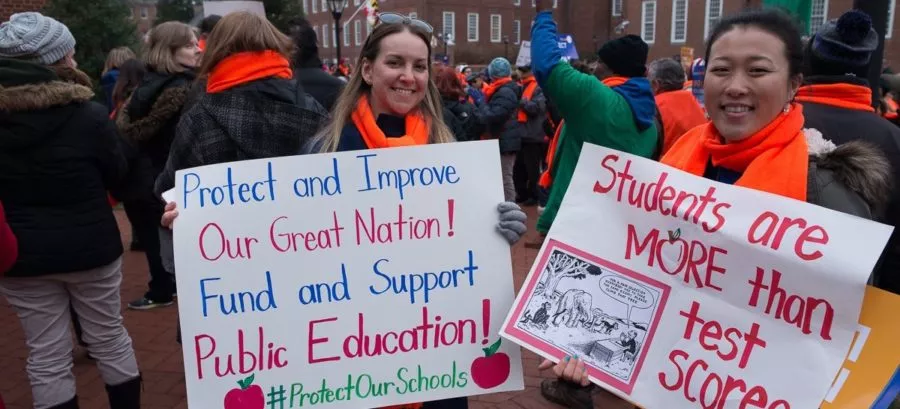From West Virginia, Oklahoma, and Kentucky to Colorado and Arizona, educators took to the streets last spring to rally for adequate K–12 funding, properly equipped classrooms, better wages, and stronger public schools. And in all sorts of other places, they’re winning victories that serve students, create stronger public schools, and strengthen the education profession. Here are a few of these important wins.
Massachusetts—Ban on Bilingual Education Repealed
For four decades, Massachusetts has required public schools to provide language acquisition programs for all English learners. Districts with large numbers of English learners in a single language group typically used transitional bilingual education—teaching in a mix of the students’ native language and English—with an increase in the use of English along the way. In 2003, that all changed when a Massachusetts law made sheltered English immersion the default model and greatly restricted the teaching of students in their native languages. No more.
Last November, the Massachusetts Teachers Association (MTA) supported a successful coalition effort to enact the new Language Opportunity for Our Kids Act. The new law gives school districts the flexibility to implement programs that best meet the needs of their students. It also provides parents with more power to ask for alternative language acquisition programs.
“One size does not fit all in education, especially when it comes to teaching English learners of different ages and backgrounds,” says MTA President Merrie Najimy. “The new law also gives parents more of a voice in how they want their children to be taught.”
North Carolina—Education Community Pushes Back on School Takeovers
Two years ago, North Carolina’s general assembly created the Innovative School District (ISD), a state managed district that typically—like Tennessee and Louisiana—turns public schools over to charter operators. This year, several local school districts were in line for a takeover by for-profit charter companies.
That was until parents, educators, principals,advocacy groups, and some school board members pushed back.
In Durham, five schools were among 48 tapped for a takeover. Organizing efforts by members of the North Carolina Association of Educators (NCAE), and other allies, brought out thousands of people who pressed the state to remove all five schools from the takeover list.
The momentum spread to other districts, like Nash-Rocky Mount Public and Northampton County Schools, where schools were removed from the takeover lists. Robeson County was originally home to five potential school takeovers. But after local pushback, only one school—Southside-Ashpole Elementary School—was selected.
Join Millions of Voices Fighting for our Public School Students and Educators
Although four schools were saved, the takeover of one is still hard to swallow. “The weight of balance was either close a school and subject 300 children to an extra hour ride on a bus—and [loss of] a foothold in the community—or submit to a school takeover,” says Dee Grissett, president of the Robeson Association of Educators (RAE). And in rural areas, like Robeson, shuttering a school could mean the demise of a community.
The collaborative efforts to gain knowledge, find answers, and seek resolution for their students united RAE members and the community. Together, they will remain vigilant.
“We united teachers, parents, clergy, and community leaders,” says Grissett, “and together we will hold the charter operator accountable for the performance of Southside-Ashpole.”
Mark Jewell, president of NCAE, says that the state association “has strong local presidents and members across this state who have been leading and standing up in community events and forums to educate our citizens about this unproven and unaccountable takeover scheme that does nothing to improve student achievement.”
‘Test Reform Victories Surge’ Nationwide
After pressure from parents, students, and educators, many states and local school districts rolled back the amount of testing and reduced high-stakes exams, according to a report released by the National Center for Fair and Open Testing (FairTest). The report, “Test Reform Victories Surge in 2017: What’s Behind the Winning Strategies?” detailed victories that eliminated tests such as graduation exams or reduced testing time. It promoted better forms of assessments, too.
Monty Neill, the executive director of FairTest and the report’s lead author, explained in a news release that “these wins often resulted from effective grassroots advocacy by parents, teachers, students, and their allies. They reflect the growing public understanding of the damage caused by the overuse and misuse of standardized testing.”
The report brings to the forefront the hard work of public school educators, with their unions and other allies.
Here are some of the biggest wins: Cut the amount of state or district testing or the time spent on testing. Maryland capped the time districts can devote to testing and ended its requirement to test all kindergartners. New Mexico eliminated the requirement that ninth and tenth graders take at least three assessments each year in reading, English, and math. West Virginia ended English and math tests in grades 9 and 10. Hawaii dropped three end-of-course high school exams along with the ACT in grades 9 and 10.
Districts that eliminated or significantly reduced local testing mandates include Las Cruces and Santa Fe, N.M.; San Diego and Sacramento, Calif.; Knox County, Tenn.; Clay County, Fla; Vancouver, Wash.; St. Paul, Minn., and Jefferson County, Ky. Victories often occurred in districts with large percentages of low-income, African American, or Latino students.
Stopped or reduced use of student test scores to evaluate teachers. In 2017, Connecticut dropped this requirement. At least seven states have done so since former President Barack Obama signed into law the federal Every Student Succeeds Act, which replaced No Child Left Behind. New Mexico joined several other states in reducing the weight of test scores in teacher evaluations.
Now allow students to opt out of tests. New policies in Idaho and North Dakota brought to 10 the number of states that allow parents to opt their children out of some or all exams.
Implemented performance assessments. Half of New Hampshire’s school districts have replaced standardized tests in most grades with local, teacher-made performance assessments. Nationally, many districts that cut their testing mandates are joined by local unions in developing better assessments.



